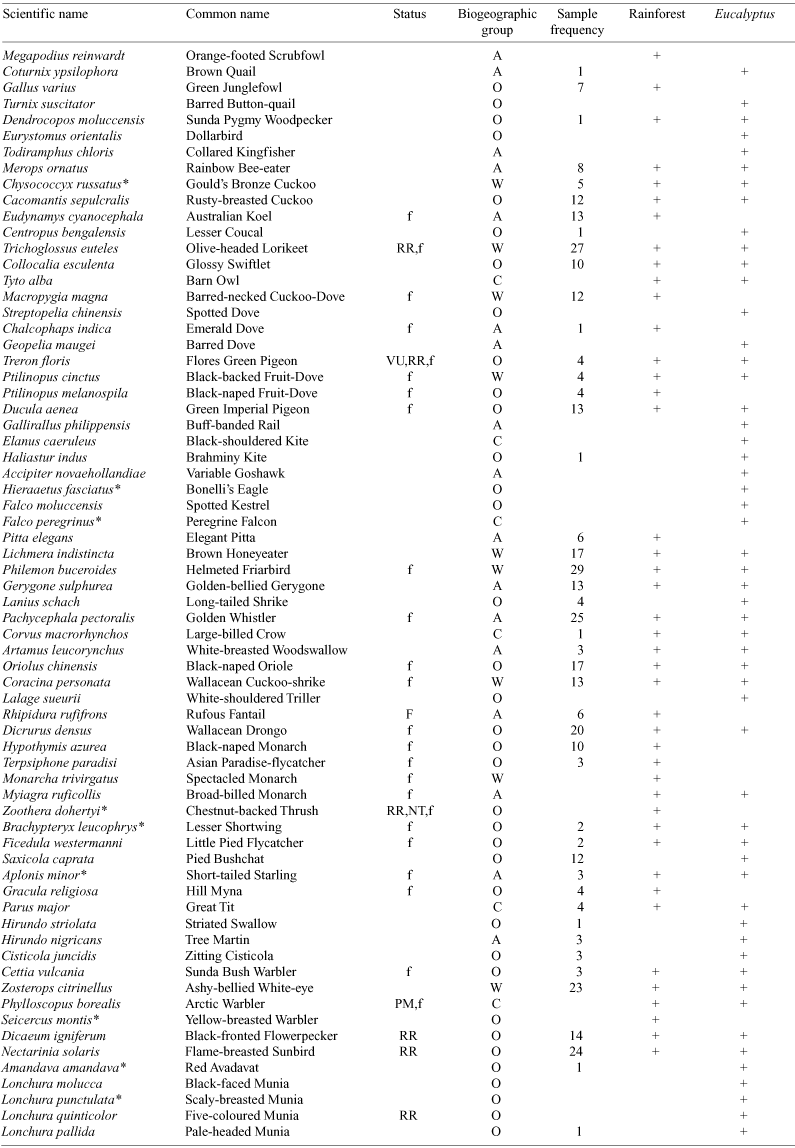Species richness, habitat use and conservation of birds of Alor Island, Lesser Sundas, Indonesia
Colin R. TrainorBirdLife International – Indonesia Programme, PO Box 310, Boo/Bogor, 16003, Indonesia. Present address: Tropical Savannas Management Cooperative Research Centre, Charles Darwin University, Casuarina, NT 0909, Australia. Email: colin.trainor@cdu.edu.au
Emu 105(2) 127-135 https://doi.org/10.1071/MU03030
Submitted: 9 July 2003 Accepted: 21 February 2005 Published: 30 June 2005
Abstract
In the Lesser Sundas, rainforest is a key habitat for endemic and threatened birds but avian community patterns on Alor Island, Indonesia, have never been examined. In May 2002, systematic observations were made in two major habitat types in Tanglapui Timur village lands to describe comparative patterns of habitat use and bird species-richness and to identify populations of restricted-range bird species. There were substantial differences in avifaunal composition between rainforest and Eucalyptus savanna, although ordination of bird species by plots revealed a continuum. Bird species-richness did not differ significantly between habitats, but the following species groups were strongly associated with rainforest: globally restricted-range species, forest-specialists, Oriental and Australo-Papuan species and frugivores. This result was associated with substantial structural differences, including greater canopy cover and canopy height in rainforest. Three species were recorded significantly more frequently in Eucalyptus savanna (Brown Honeyeater, Lichmera indistincta; Golden-bellied Gerygone, Gerygone sulphurea; and Pied Bushchat, Saxicola coprata). All six restricted-range species known from Alor were recorded, indicating the importance of the study site for conservation. Study is needed of the taxonomic relations of Alor populations of Lesser Shortwing (Brachypteryx leucophrys) and Yellow-breasted Warbler (Seicercus montis).
Acknowledgments
Heri Ndolu provided great support by making logistical arrangements and forging local contacts. Thanks to Neny Herdianawati (World Wide Fund for Nature, Kupang, Nusa Tenggara) for making some logistical arrangements; to Agustinus Mapota, Abia Mokoni and Simon Mokoni for guiding us around Mount Koya Koya; and to Yakob Mapota for providing information on local bird names and their meanings. Thanks to Meleyaki Mapota, the village head of Tanglapui Timur for his hospitality and interest during the visit. BirdLife International – Indonesia Programme obtained visas and permits through the Indonesian Forest Protection and Nature Conservation Department (PHKA) and provided field equipment. Don Franklin and John Woinarski kindly commented on a draft of the manuscript.
Hartert, E. (1898). On the birds of Lomblen, Pantar and Alor. Novitates Zoologicae 5, 455–476.
Johnstone, R. E. , and Darnell, J. C. (1997a). Description of a new subspecies of bush-warbler from Alor Island, Indonesia. Western Australian Naturalist 21, 145–151.
Olsen, J. , Wink, M. , Sauer-Gurth, H. , and Trost, S. (2002). A new Ninox from Sumba, Indonesia. Emu 102, 223–231.
Poulsen, M. K. , and Lambert, F. R. (2000). Altitudinal distribution and habitat preferences of forest birds on Halmahera and Buru, Indonesia: implications for conservation of Moluccan avifaunas. Ibis 142, 566–586.
Rozendaal, F. G. (1987). Description of a new member of bush warbler of the genus Cettia Boonaparte, 1834 (Aves: Sylviidae) from Yamdena, Tanimbar Islands, Indonesia. Zoologische Mededelingen 61, 177–202.
Trainor, C. R. (2002a). Birds of Gunung Tambora, Sumbawa, Indonesia: effects of altitude, the 1812 cataclysmic volcanic eruption and trade. Forktail 18, 39–51.
Woinarski, J. C. Z. , Brock, C. , Armstrong, M. , Hempel, C. , Cheal, D. , and Brennan, K. (2000). Bird distribution in riparian vegetation in the extensive natural landscape of Australia’s tropical savanna: a broad-scale survey and analysis of a distributional data base. Journal of Biogeography 27, 843–868.
| Crossref | GoogleScholarGoogle Scholar |


|

